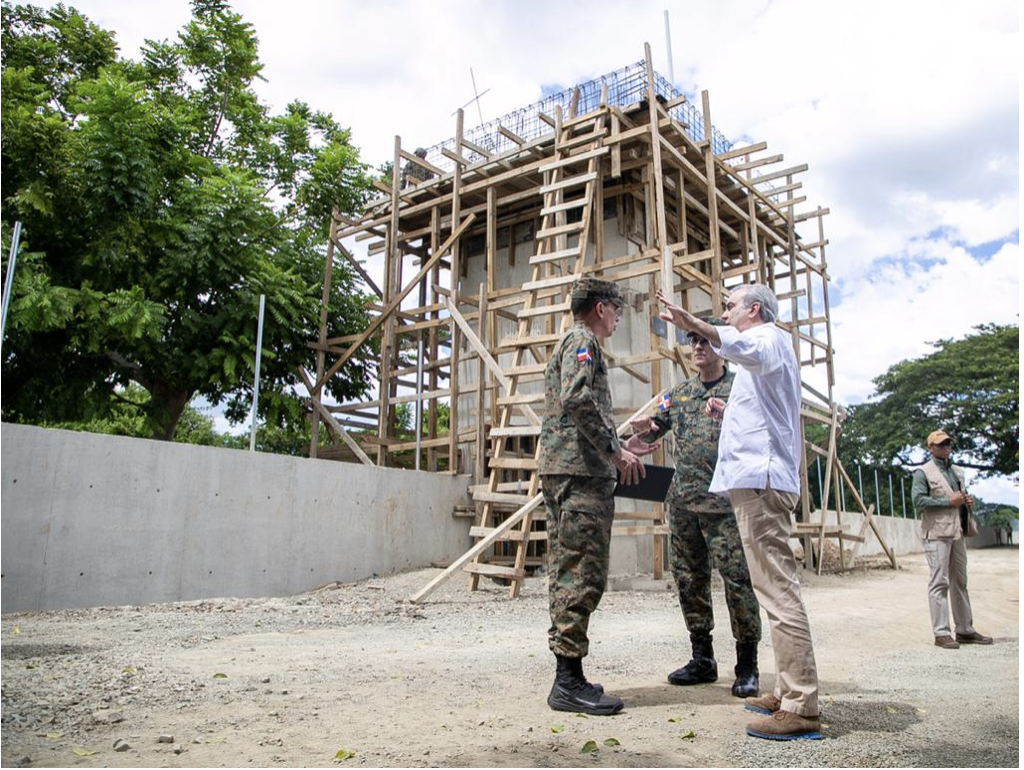
President Luis Abinader was at the border with Haiti this weekend from where he announced new measures to enhance security as the multidimensional crisis in Haiti worsens. Speaking from Dajabón, President Abinader announced major US military equipment purchases for the border armed forces.
In a tweet on Sunday, 10 October 2022, President Abinader backed the call by United Nations secretary general for a specialized international force to assist the Haitian Police to revert the situation in Haiti. “We strongly support the urgent call by @antonioguterres of the @UN for the deployment of a specialized international force to assist the Haitian police in reversing the humanitarian and security crisis in that country. We must act now. Haiti can’t wait any longer,” President Abinader wrote on his Twitter account.
President Luis Abinader said on Sunday, 10 October 2022, speaking at the border, that in the event of intervention in Haiti, the Dominican Republic would not be part of a military force and that the support it would give would be from the diplomatic point of view.
Abinader said that the Dominican Republic does not accept the establishment of refugee settlements in the country, even in a humanitarian situation. He says these settlements need to be organized in Haitian territory.
President Abinader spoke in these terms during a press conference in Dajabón. He was accompanied by First Lady Raquel Arbaje; the Minister of Defense, Lieutenant General Carlos Luciano Díaz Morfa; the general commander of the Army, Major General Carlos Antonio Fernández Onofre; the director of the Specialized Corps for Border and Land Security (Cesfront), Brigadier General Frank Mauricio Cabrera Rizek; the governor of Dajabón, Rosalba Milagros Peña, and Congressman Darío Zapata.
As announced on Sunday in Dajabón by President Abinader, the Dominican government is in the process of purchasing six Huey II helicopters, 10 new aircraft for reconnaissance and surveillance.
The new helicopters will effectively fulfill tasks such as aerial reconnaissance and surveillance, tactical operations, personnel transport, search and rescue, medical evacuations, cargo transport, forest fire fighting and training.
A Southern Command of the Air Force in Barahona would be created in the southwestern region, among other measures. The provisioning is complemented by the updating and modernization of radio navigation aids, a new control tower and lighting system at the San Isidro Air Base in eastern Santo Domingo.
The new equipment includes 21 armored personnel carriers and 4 anti-riot trucks to equip the Army of the Dominican Republic. The armored vehicles are the largest acquisition of this type of vehicles by Dominican governments since 1961. The equipment will enable the enforcement of the key gateway points — Jimaní and Dajabón — for vehicular and entry of pedestrians.
As reported, the military equipment is of the latest generation of the URO brand, Vamtac ST5 model, with a capacity to transport nine troops and are equipped with automatic weapons for self-defense.
The President also announced provisions to improve the living and working conditions of the soldiers serving at the border in the 10th, 11th, 14th and 16th Infantry Battalions. A monthly stipend of RD3,500 is added to their wages.
President Abinader said that as of January 2023 all soldiers who reenlist will receive a 5% salary increase, valid for retirement purposes and as a recognition of their years of service.
He announced the construction of a new housing complex for 400 new soldiers and the remodeling of the Beller Fortress in Dajabón, seat of the Tenth Infantry Battalion of the 4th Brigade of the Army of the Dominican Republic. A new hangar for helicopters and armored vehicles, dining room, multipurpose room and other facilities are being added.
The measures seek to control the illegal entry of immigrants, safeguard the border zone and contribute to formalize trade for the benefit of both countries.
The Abinader administration has underway a first phase of a 54-kilometer intelligent border fence, made of reinforced concrete and metal structure, with 19 surveillance and control towers, 10 access gates for patrolling and 54 kilometers of roads for surveillance and maintenance on both sides. The intelligent border fence will have motion and thermal sensors, security cameras and high-capacity military-style drones, among other features. It will be continued with a second stage that will complete a 173-kilometer extension of the 391.6-kilometer borderline.
The Dominican Republic has stated its solidarity with the inhabitants of the neighboring country through national and international channels. At the same time, President Abinader has stressed that the solution to Haitian problems is the responsibility of Haitians and that there cannot be a Dominican solution to the Haitian crisis. Over the years, nevertheless, the Haitian border has been more open than closed to Haitian immigration. The Dominican government freely allows undocumented residents in Haiti to cross on market days and return in the afternoon. There is no control on who returns.
Likewise, city mayors and legislators have pointed out that the military look the other way and allow thousands of Haitians to commute to hospitals for free medical services and to get to job positions nationwide. Thousands of Haitians go to school in Dominican public schools on this side of the border. Likewise, while this is considered contraband, the military have looked the other way and allows thousands of gallons of fuel to be purchased in the Dominican Republic for resale in Haiti.
Read more in Spanish:
Presidency
Presidency
Listin Diario
El Caribe
Hoy
Hoy
Diario Libre
Hoy
10 October 2022

